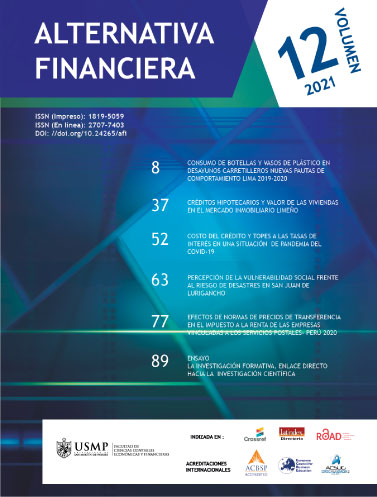Effects of transfer pricing rules on the income tax of companies linked to postal services - Peru - 2020
Keywords:
Transfer Prices, Tax Base, Income Tax, Financial Statements, Utilities, Arm´s Lenght principle, Market Value Related Companies, Postal Services,Abstract
This research carried out the analysis and evaluation of the incidence of the normative application of transfer prices in the Income Tax for related companies that provide postal services, a sample of 92 companies that provide postal services located in Metropolitan Lima has been carried out. , using as data collection instruments surveys directed at managers, administrators and accountants; It was found that they indicated that the accounting information reflected in the Financial Statements does not issue their internal information based on the current transfer pricing regulations, so the corresponding adjustments will have to be made through working papers for the affidavit and therefore both there will be an adjustment in the Income Tax; Therefore, the results obtained determined that if the price agreed between the related parties does not adjust to those of the free market, then it will not obtain a real tax base of the Income Tax; It has been concluded that any commercial transaction that avoids complying with the transfer price regulations (Arm’s Length principle) with related companies, and they have not made the corresponding adjustments at the end of the year by modifying the corresponding Tax, then SUNAT will make the adjustments respective and apply the corresponding sanctions; It is always recommended to be analyzing the market values under the arms legth principle and to find discrepancies with this, make the corresponding adjustments before filing the Income Tax Affidavit.
Downloads
References
Catacora, L. (2015) Aplicación de los precios de transferencia entre empresas vinculadas y su incidencia en la determinación del impuesto a la renta. Caso: transportes Kala S.A.C. pág 12.
Cordon T, (2007) Manual de Fiscalidad Internacional, Lima, Instituto de Estudios Fiscales. pág 345-356.
Cosenza J (2002) Los precios de transferencia desde una perspectiva de una agencia y sus efectos en el control de gestión. Tesis para optar el grado de Doctor en la Universidad de Zaragoza, España, pag.35.
Diaz E. (2017) Análisis del principio de plena competencia de las operaciones con partes relacionadas de la empresa Alamedaecu Comercio S.A. del periodo fiscal 2015 y carta diagnóstico que incluye la evaluación obtenida de precios de transferencia. Pág 32.
Esteve M. (2013) Fiscalidad de las operaciones entre sociedades vinculadas y distribuciones encubiertas de beneficios, Barcelona, Editorial Caballo Blanco, Pág. 131.
Fuster M. (2015) La doble imposición internacional en las inversiones directas en el exterior de empresas españolas, Madrid, Ediciones Jurídicas y Sociales, S.A. Pág. 23.
García, R. Manual de Impuesto a la Renta, Santo Domingo, Editorial Inst. de capa tributaria, 2016 Pág. 257.
Gómez J. (2017) Precios de transferencia. México, Editorial Dofiscal, Pág. 111.
Nima, E. (2018) Impuesto a la Renta de Empresas, Contadores y Empresas, Editorial El Búho, enero. Pág. 6.
Chávez, P. (2003) Impuesto a la Renta, Lima, Editorial UNMSM 2013, Pág. 48.
Pascual A. (2003), Impuesto a la Renta, Lima, Editorial UNMSM, Pág., 48
Pimentel, F. (2014) Globalización y control de precios transferencia. Sao Paulo, Editorial Pórtico, Pág. 143.
Ramírez L. y Niño de Guzmán L, Los precios de transferencia y su incidencia tributaria financiera en las empresas vinculadas de fabricación de productos plásticos ubicadas en el distrito de Lurín, Lima-Año 2017. Universidad Peruana de Ciencias Aplicadas (UPC). Lima, Perú. https://doi.org/10.19083/tesis/624825.
Sharpe A. (2015) Fundamentos de Inversiones, Barcelona, Editorial Griley, Pág.119.
Downloads
Published
Issue
Section
License
Creative Commons Atribución-NoComercial-CompartirIgual 4.0 Internacional (CC BY-NC-SA 4.0). Faculta a los usuarios a compartir: copiar y redistribuir el material en cualquier medio o formato y adaptar: remezclar, transformar y desarrollar el material, siempre y cuando se acredite al autor original, no se utilice con propósitos comerciales y las nuevas creaciones se licencien bajo los mismos términos de esta licencia.













